Text
Evaluation Task
On the site: https://www.noteboardapp.com/11taylore , you can find questions 1 - 7 of the evaluation of my final project.
0 notes
Text
Final Project
https://www.youtube.com/watch?v=yMb9vmWId2s&feature=youtu.be
0 notes
Text
TV Drama Scene Analysis - Game of Thrones - Tyrion’s Trial and Speech
This scene takes place at the conclusion of Episode 6 of the Fourth Season of Game of Thrones, HBO’s critically-acclaimed Drama/Fantasy series. For contextual purposes, the character of Tyrion Lannister (Peter Dinklage) is on trial after being accused of the murder of the former King, Joffrey Baratheon. Throughout the trial, Tyrion is interrogated by his father Tywin (Charles Dance), while various witnesses are called to make testimonies on both sides of the trial. This scene picks up as Tyrion is slowly beginning to realise that the trial is fixed to make him be found guilty, and he has an outburst in anger at the corruption in the trial.

Much of the focus throughout the scene is on Tyrion, and he has the most screen-time of any other character in the scene, showing that it is from his ‘perspective’ that the scene is playing out. For much of the scene, we are given a mid-shot of Tyrion, which also acts as a shallow focus shot; not only is the shot framed from Tyrion’s chest upwards, but we can also see the peasants who are acting as the trial’s jury in the background, even though they are out of focus. As Tyrion tries in vain to justify himself, we are given more shallow focus shots, which also act as reaction shots showing some of the other important characters in the room, who have non-speaking parts in this scene, such as Cersei Lannister (Lena Headey) and Margaery Tyrell (Natalie Dormer). We are shown both of their characters, but also see some less important characters sat alongside them, out of focus.

Another of the reaction shots to Tyrion’s speech also acts as a low-angle shot, as we are shown Tywin sat on the Iron Throne, framing him to clearly be the one with all the power and leverage in the scene. As Tyrion realises his pleas are futile, he reluctantly announces that he “wishes to confess”. At this statement, we are given a mid-shot of Jaime Lannister (Nikolaj Coster-Waldau)’s shocked reaction, another important character who serves a non-speaking role in the scene.

Tyrion then turns to jury behind him, stating that he saved them and the city, but in hindsight should have let them all be killed (this is in reference to the climactic battle of Season 2). As the jury begin to speak up in uproar, we are given an impressive master shot of the room, showing Tywin and the judges sat at the front of the room, Tywin framed by the Iron Throne, with Tyrion stood facing him, back to the camera, while the two rows of the jury sit either side.
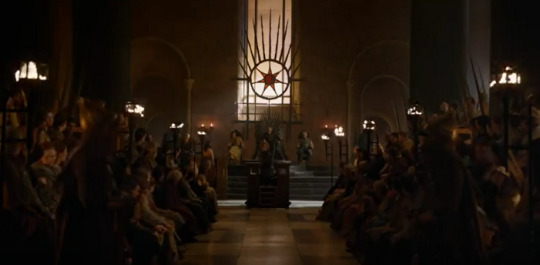
As Tyrion goes on, announcing that he is guilty, while still not actually naming the crime he’s guilty of, we are given a shot-reverse-shot as Tywin demands that Tyrion verbally confess to poisoning the King. We are then given a variation of a tracking shot, as the camera moves backwards to follow Tyrion advancing towards the front of the room, claiming that what he’s guilty of is simply “being a dwarf”, something he claims to have been “on trial for his entire life”.
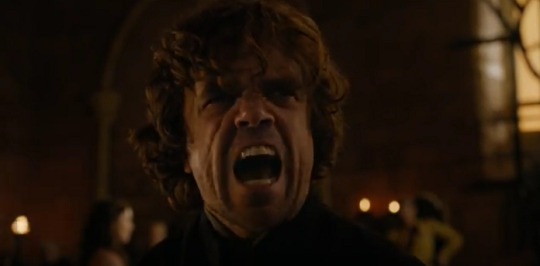
Tyrion then claims he “did not kill Joffrey but wishes he had”, as it would have given him great pleasure. We are then given an over-the-shoulder shot as Tyrion turns back towards the jury, claiming that he wishes he was the monster they all believe him to be. At this point, as Tyrion clearly begins to snap under the pressure of the trial, the soundtrack, which has been purely diegetic up until this point, begins to pick up, giving us a slow, melodramatic, orchestral tune. The over-the-shoulder shot, which is now also acting as a shallow focus as we can see Tywin and the judges in the background, continues, as Tyrion claims he wishes he had enough poison for everyone in the room. We then revert back to the master shot as Tywin stands from the Iron Throne, ordering his guards to have Tyrion removed from the room.

As Tyrion turns back to Tywin, saying he knows the trial is unjust and thus demanding a trial by combat, Tywin is again framed via a low-angle shot, showing that, although Tyrion currently has the spotlight, Tywin is still the one in power. We are then given reaction shots of much of the aforementioned non-speaking roles, Cersei, Margaery, Jaime, as well as Prince Oberyn Martell (Pedro Pascal). The music picks up now, drowning out the sound of the shocked jury talking amongst themselves, as the camera gives us a combination of shot-reverse-shot and zoom, as Tyrion and Tywin stare hatefully at each other.
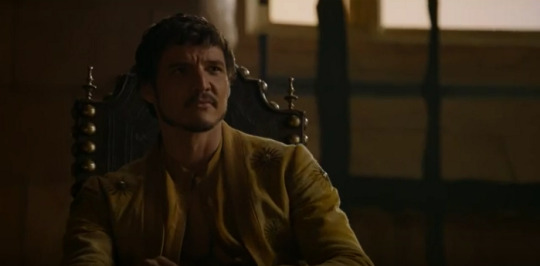
In terms of the behind the scenes aspects of this clip, such as the editing and mise-en-scene, the time between takes in the editing is fairly long, as this is a scene focused far more on the war of words rather than the literal war. Most of the mise-en-scene is simply constructed, with the location and costumes being fairly typical of this sort of ‘medieval fantasy’ type project.

The location is what may come to mind when thinking of a throne room, it’s a large room that is decorated with various types of memorabilia on the walls, with the large throne at the head. The costumes vary, with the royal Lannister and Tyrell family characters dressed in robes and dresses, while the peasants in the jury are dressed in dirty and dull coloured clothes. However, it is also interesting to note that this is one of few projects, film or television based, that puts a character with a clear physical disability or ‘handicap’ at the forefront of the action, both literal action as well as metaphorical.

0 notes
Text
Film Opening Scene Analysis 2
Film Title: Drive
Starring: Ryan Gosling, Carey Mulligan, Oscar Isaac, Bryan Cranston, Christina Hendricks, Albert Brooks and Ron Perlman
Director: Nicolas Winding Refn
Genre(s): Drama, Crime, Thriller
Drive is a stylistic drama film directed by Nicolas Winding Refn, focusing on Ryan Gosling’s unnamed ‘Driver��� a getaway driver for hire in Los Angeles. This is an analysis of the opening scene of the film, in which we are introduced to the Driver, the way he operates, and how he often escapes the police. While this description may seem perfect for the opening of an action film, it is directed and shot in a far more subtle way.

The film begins on a black screen, the Driver monologing that his employers will give him a time and a place, and he gives them a five minute window, allowing them to commit whatever crime they’re planning while he waits for them. The camera shows us a map of Los Angeles laying on a table, before panning up to show the Driver staring out of a window towards the neon, illuminated, Los Angeles skyline. The Driver continues, saying that if anything happens a minute either side of the five minute window, and the employer will be “on their own”. The pan continues around the room, showing a television playing highlights from a basketball game, and a duffel bag on a bed, which the Driver then walks over and picks up, leaving the room.

We then cut to a shot from the interior of the Driver’s car, acting almost as a first-person shot, only the dashboard and the Driver’s hand on the steering wheel visible on the interior of the car, as well as his reflection in the rear-view mirror. We then get a low-angle shot of the Driver, skyscrapers visible outside of the car as he passes them. Also, the only sound here is diegetic, with the sound of the car on the road the only car present. The scene then cuts to a scene, presumably from earlier in the story, where we are introduced to Shannon (Bryan Cranston), the Driver’s boss at a mechanic’s where he works. We are given a tracking shot of the two walking through the mechanic’s, as Shannon tells the Driver about a new car that has been delivered.

It’s revealed that Shannon knows about the Driver’s exploits as a getaway driver, as he states that the car is inconspicuous so no-one will be looking for him. The soundtrack then picks up to an electronic beat, as the scene cuts to a shot of the Los Angeles skyline again, now panning across the city. The scene then cuts back to the Driver in his car, with a shot of his reflection in the rear-view mirror. The Driver arrives at what looks like a bank, where he looks at two men stood across the road, hinting that they are his employers. We are then given a shot from inside the car as the two men, who’s faces are concealed by balaclavas, pass the car and open a gate, heading into the bank.

The Driver then takes off his watch and straps it to the steering wheel, showing how insistent and serious he is about the five minute window. We then hear the sound of an alarm being triggered from within the bank, suggesting that the two robbers presence has been discovered. The Driver then takes out a handheld radio, monitoring for police chatter. We are then given another shot of his reflection in the rear-view mirror, as he turns up the in-car radio, now listening to commentary of a basketball game, maybe the same one on the television earlier in the scene. One of the two men then emerges from the bank, as we can hear from the radio that police are reporting a series of fired gunshots. We are then given a shot from outside the car, zooming in as the Driver leans over and opens the back door, allowing the first robber to get in. We then again see the Driver’s reflection in the rear-view mirror, as he now looks over at the robber, who is waiting intently for the other.

We then hear from police chatter that an officer is reporting that he is only two minutes from the bank. The camera then zooms to the Driver, staring intently at the bank door as the second robber eventually emerges and rushes to the car, while the sound of police sirens grows louder. The Driver then pulls away from the bank, but quickly pulls in behind a parked truck as a police car rounds the corner. This is shown by a camera mounted on the car’s bonnet. As the police car slowly passes, and the Driver watches it go, we can hear both the electronic beat, which has been playing continuously since it started, as well as the sound of the basketball commentary on the radio. The Driver then accelerates away, seemingly agitated that the police car may notice him. Eventually, the Driver reaches a bridge, where a police helicopter is seen hovering, using a spotlight to scan the cars on the bridge. We are again shown this by the ‘first-person’ shot from within the car.
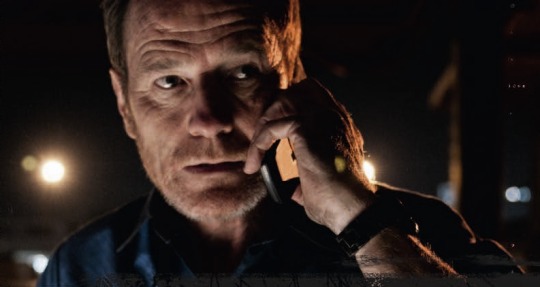
As the helicopter spotlight lands on the Driver’s car, and we hear on the police radio that they have identified the car as the one they’re looking for, the Driver accelerates along the bridge. We are shown the two robbers in the back, who have since removed their balaclava’s, who are seemingly confused by the Driver’s tactics. The Driver exits the bridge and parks in a secluded area under the bridge. We are shown the faces of the Driver and the two robbers, as we see the spotlight pass over the car and hear the deafening sound of the helicopter’s blades. We then hear over the police radio that there is a possible gang shooting in progress, and we see and hear from the bonnet-mounted camera that the helicopter is leaving. As the Driver pulls away, the electronic beat stops, and we hear the sound of the basketball commentary again.

We are then given a head-on close-up of the Driver, as he turns the basketball commentary up, drowning out what remains of the police chatter. However, the scene then intensifies again, as the Driver stops at a traffic light, where a police car is stopped opposite. As the Driver watches the police car, we hear from police chatter that the police have identified the Driver’s car as a suspect vehicle, while we also hear the electronic beat again, although this time louder. As the Driver then pulls away from the traffic light, we see and hear the police car turn on it’s sirens. As the Driver speeds away from the police car, we see from a shot on the rear of the car that the police car has turned around to follow the Driver. We see the Driver overtaking pedestrian vehicles via the first person view and, while the sound of the car engine and tyres on tarmac is loud, we can still hear the sound of the basketball commentary on the radio.

The Driver turns a sharp corner and seemingly loses the police, while the commentary is linked up, as the basketball commentator counts down the final five seconds of the game, while the Driver seemingly loses the police. We are then shown the two robbers exchanging glances, seemingly shocked by the Driver’s ability. In a great use synching up two plot points, we see the Driver pulling into an underground carpark, filled with sports fans waving scarves. It is suggested that this is the stadium or arena where the basketball game was being held. The Driver then parks his car and exits it, leaving the two robbers inside. As we hear more police sirens approaching, the Driver changes his hat and jacket, now disguising himself as one of the sports fans, as he passes a police officer unnoticed, before the screen cuts to black and the subsequent title sequence.

There are a number of different shots in this scene that fall into an interesting category. While they are fairly unique in the way that they’re not commonly seen in other films, there are a number of shots that are used multiple times throughout this scene, and then again throughout the rest of the film. The editing varies but is still as expected; during the more fast paced moments in the car chase, the time between takes is very short, but during the slower scenes, such as the Driver waiting outside the bank, the editing is slow and methodical. The use of the soundtrack throughout this scene is very effective, as the moments where the only sound is diegetic feel more realistic and tense, but the music used is something that is not commonly seen throughout mainstream films, and so when used feels unique and well thought out. In terms of the mise-en-scene, Ryan Gosling does a great job of playing a character who is quietly intense, able to convey his emotions more through his actions and looks rather than through words. The two robbers in this scene have a very limited screen time and lines, and are dressed pretty much as expected. Gosling’s Driver wears a silver jacket with a gold scorpion on the back, something which has become a symbol of the movie. The location is interesting, as the majority of shots in this scene come from in and around the Driver’s car, meaning that, combined with the aforementioned used of diegetic sound, it makes the action feel more claustrophobic and manic.

2 notes
·
View notes
Text
Main Project - Storyboard
This is the basic ‘first-draft’ of a storyboard for our project. While it is likely that the framing of some shots may change, or some may need to be re-shot because the shot we ended up with wasn’t satisfactory, the main overall idea behind these shots should stay the same, and the majority should not pose any real challenges to us.

Here is the first slide.
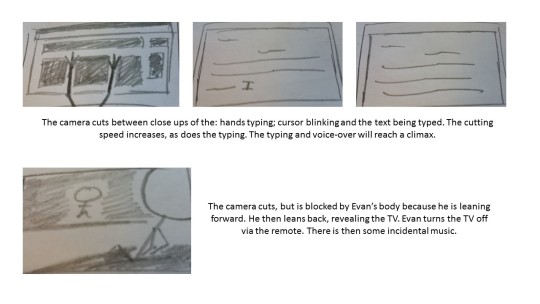
Here is the second slide.
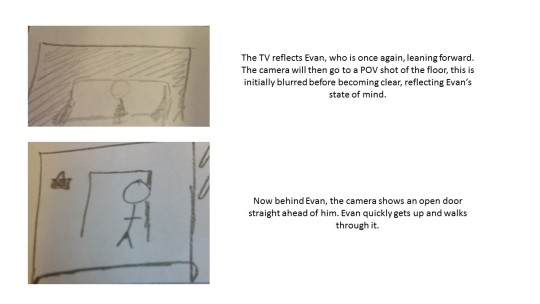
Here is the third slide.

Here is the fourth slide.
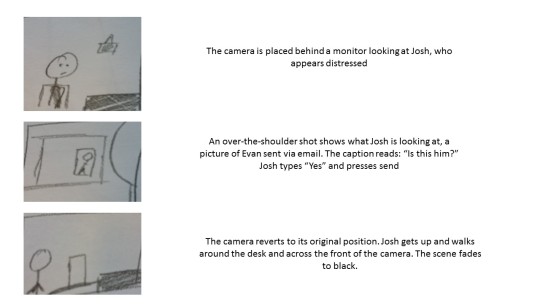
Here is the final slide.
0 notes
Text
Research Into Other Film Openings - Survey Feedback
When preparing for our main project, we decided that we should try and find a film opening that proves to be similar to our idea. With research done, we settled on the opening scene of L.A. Confidential.
In total, we had 20 people take our survey, which involved them watching the opening two and half minutes, and then answering eight questions, four of which were based around the scene they’d just watched, while the other four focused on thriller films in general.
Features from L.A. Confidential such as the voice over, archive footage, and change in tone are aspects that are intended to work their way into our project. There are no questions about anyone’s personal preferences, as I wanted to make sure that the answers I was getting were exactly what I wanted.
After question four, the survey switches to questions about thrillers in general, such as the dependency on action scenes, and the potential of including some sort of plot twist. In question seven in particular, I am I interested in the users’ preferences I audio, and how this can be used to build tension in a piece, something I intend to do.
As all thrillers are different, these conventions may not be present in all thriller films, but they are specific to what I am hoping to create in mine.
Voiceover
All 20 survey participants said that they found the voiceover useful and beneficial, and the general consensus was that this is because it quickly gives you a bit of backstory about the time period and location.
Expectations
Based on these answers, we then asked what the survey participants would expect from the rest of the movie, based on this opening voiceover. Some expected the film to be a crime thriller, but the most useful piece of information was that not everyone knew whether the person delivering the voiceover (Danny DeVito) would be the protagonist or antagonist of the story, as both the script itself and his tone carry a great deal of ambiguity. This is helpful as we plan to include a voiceover in our clip, which will prove to be the main source of information.
Mood/Tone
Most people were surprised by the sudden change in mood throughout the survey, as the contrast and sinister undertones were intriguing. This is helpful as it shows that a sudden change in mood/tone doesn’t necessarily derail a project, which is useful as I plan to use something similar in my project.
Poll: Based on this clip, would you watch other thriller films?
Of the 20 people who took part in the survey, 16 said they definitely would watch other thriller films, while 1 definitely said they would not. There was then 3 who said ‘maybe’. Of these three, two said ‘yes’ despite not liking the example of L.A. Confidential, while 1 said they would as long as the thriller in questions was not gratuitously violent.
Archive Footage
The responses to the question about L.A. Confidential’s use of archive footage were mixed. Some thought that it was useful and made the film more realistic, while others thought that the low quality of the short clips was a bit jarring. This is useful as we are planning on using manipulation of archive footage in our project and, if done correctly, can add a great deal of realism and immersion.
Action Scenes
We felt it was needed to ask about the type of action in a thriller film as, although our film is technically a thriller piece, it does not include any conventional action. So, we asked what type of action scenes the survey participants would expect to see in a thriller film, and the answers were very varied;
o Car Chases
o Gun Fights
o Fist Fights
o Chases On Foot
o Prolonged Cat-And-Mouse Style Chases
While I think that all of these are valid examples, and give an idea of what people expect from a thriller film, I don’t plan on using any of these in my piece. This is because I do not believe that I would be able to facilitate an action scene in my piece, based on the overall length and style of the piece, and the overall behind-the-scenes issue of the technology we are using. Therefore, we plan to divert more focus to building tension and atmosphere, rather than trying to fit in a fight scene.
Sound
We then asked whether it would be acceptable to have any scenes in a thriller without sound, and thankfully only 1 person out of the 20 said ‘no’. 7 said ‘yes’, while 8 said ‘sometimes’. Of those 8, 5 said that it would be expected if it were being used to build tension (which is what we intend to do), while 2 said that it might be expected if the film called for some sort of dream sequence, while 1 said that, while they may not be in favour of it, it would be acceptable in the film as long as it is not particularly prolonged.
Plot-Twist
Of all people asked in the survey, nobody said that a thriller should definitely not have some sort of plot-twist. 14 said yes, it definitely should, while 6 said ‘sometimes’. I’m indifferent in this conversation, I think that, if done well, a twist can be the most memorable part of a film, but can be a let-down if seemingly being shoehorned into the final project, but a film can also be a let-down if it does not include a twist. While we do not plan to include a real ‘plot-twist’, we do plan for the reveal of the antagonist to be somewhat surprising. However, whether or not that is big enough to constitute a twist remains to be seen.
0 notes
Text
Main Project Screenplay
It is likely that the end project is going to end up slightly different from what is written here, as we discover potential issues, obstacles and even other ways of filming. However, we will still refer to this screenplay, and aspects of the final project will definitely reflect what is written here.
The camera pans from right to left, going from a blank white wall to me sat on a sofa with a laptop – (other objects may be in view once the pan starts, like doors, pictures and ornaments etc.). The laptop can either be on my lap or on a coffee table that I am leaning towards. The camera must pan from right to left so as to reveal as little of the room and scene as possible. Just before the pan ends, an over-voice begins*. The pan finishes, focusing on me, who is typing on the laptop.
An over the shoulder shot focuses on the laptop screen. I am typing onto a Word document**. A small portion of the television, the right hand side, is visible down the left hand side of the frame. The voice-over syncs up with the partial image on the television. The shot will transition from over the shoulder to a perfect frame of the television. It is now clear that the voice-over and image are one, news coverage of a police spokesperson***. The over the shoulder shot is resumed, but there is greater focus on what is being typed.
The camera will cut between close ups of my hands typing, the cursor blinking, and the text, there will also be an over the shoulder shot of all three. The news coverage and typing will eventually reach a climax.
The cutting speed increases between the close ups, the speed and sound of typing increases also. The camera then cuts and is mostly blocked by my body. When the typing reaches its climax, I quickly lean back against the sofa. The television is now clearly visible and unobstructed. The voice-over from the spokesperson now also reaches its climax. At this point there is incidental music. The camera doesn’t move as the news coverage ends. I turn the television off via the remote. The incidental music ends with the exaggerated sound of the television turning off.
The camera doesn’t move, as the television reflects me. I then lean forward, once again blocking the camera. The camera cuts to a high angle shot of me, and I’m clearly frustrated and thinking. I am leaning forward, my arms either resting in front of me or hanging. The camera cuts to a POV shot, as I’m looking down, only the carpet and part of the coffee table are in frame, but they are slightly blurred as I am thinking. After a few seconds, the picture becomes clear again, showing my clarity after thinking.
The camera is now placed behind me. Straight ahead is an open door. I get up, partially blocking the camera, and walk straight ahead and through the door; out of view.
The camera cuts to just past the door. A straight shot of the hallway is given. I enter through the door from the left and walk towards the end of the hallway, where the front door is. The camera follows, performing a tracking shot. I stop abruptly, as does the camera, and I turn sharply to my right, then entering the kitchen. The camera stays still as, off camera, I’m searching for something, the sound of cutlery crashing together plays before stopping. A second later, I walk out calmly. I sharply turn to the door and open it before walking through and closing it. The camera still hasn’t moved and continues to hang as I stand still on the other side of the door. My silhouette is visible through the glass.
The camera cuts to a shot of Josh sat at a desk. The camera is positioned behind and above a computer monitor, which blocks the lower edge of the frame. There is some incidental music as there is then an over-the-shoulder view as Josh looks at a picture of me on the monitor, the caption reads: “Is this him?”. The music builds and becomes tense. There is then an extreme close up on the blinking cursor as Josh types “Yes”, accompanying this is the exaggerated sound of typing. The music stops abruptly as Josh presses SEND.
There is silence as the camera returns to its initial position, behind and above a computer monitor. Josh gets out of the chair and walks around the desk and across the front of it from left to right, blocking the camera as he goes. A door can be heard opening as the screen begins to fade to black, accompanied by the sound of the same door closing. The scene ends on the “bang” of the door once it closes. ****
*The voice-over script will be written once a suitable clip is found. Without the clip, there is no knowledge of how long the script has to be.
**The script or the typing will be written once we work out how long the scene will be. That way we can write a script of appropriate length and detail.
***A suitable clip must fit in with the overall length of the scene. Therefore, a single clip cannot be chosen until we work out the relevant timings.
****Credits will be inserted during the editing process. It is difficult to say when and how they will fit it until then.
0 notes
Text
Preliminary Task - Write Up
Here is a link to my Preliminary Task: https://youtu.be/i5ieLxp7gfU
I believe that the camera work in my project is the strongest aspect of it, as it was clear to see a number of different types of shot used throughout. Among these are; tracking shots; close ups; over the shoulder and establishing shots. However, we could be criticised for an ‘over-dependence’ on tracking shots, as, although only two were used, they were both the longest takes in the video, and therefore took up much of the run-time.
The main issue with the footage though, was the stability, or lack thereof. The camera was shaking a lot, which is something that will be resolved next time by using a tripod. Without a big rig or some sort of expensive equipment, it is hard to do any shot, let alone a tracking shot, with complete stillness. However, I still intend to use a tracking shot in my main project as I believe it is a very clever way of showing the importance of a certain character or object in a scene.
The soundtrack is also something that will definitely have more time spent on it, as I also believe that it is one of the most important aspects of any project, and could be considered the most important in our upcoming practical task. When it comes to dialogue in our preliminary, we had to dub over some of our original dialogue, as the original was hard to hear above the background interference. This was a very successful piece of editing as no-one seemed to notice that one actor had someone else’s voice completely. The entire, original, audio track was scrapped for the same reasons as the dialogue. When it comes to our main practical task, I do not plan on having a large amount of dialogue, for the sake of atmosphere, so I will instead focus the majority of my attention on the non-diegetic aspects - such as incidental music and voice overs, both of which were lacking from the preliminary, which just had one long music track in its place. Overall, the soundtrack in this preliminary task was very basic, something that will be greatly improved upon in our main project.
Location was something that we were quite limited with. We couldn’t spend hours scouting locations, so the suggestion was made by another member of my group to use the sixth form toilets as the setting of our piece, an idea I thought was good and agreed to. Subsequently, we received comments in the feedback for the originality of our choice. It was a change from the common backdrop of classrooms, and this was one of the main reasons I was in favor of this location. In the future, we will make decisions on location based on how they relate to the piece and mood we are aiming for. In this case, the toilet helped in the attempt to create humor, whilst in the main project, a simple family home will create a sense of calm and well-being, something that will become more apparent why in the final project.
Next time around we will spend more time on each part of the process. During the creation of this project, I gained a lot of confidence in my film-making skills, and have discovered how to improve in the future.
0 notes
Text
Film Opening Scene Analysis
Film Title: Sicario
Starring: Emily Blunt, Benicio del Toro, Josh Brolin, Daniel Kaluuya, Victor Garber and Jon Bernthal
Director: Denis Villenueve
Genre(s): Drama, Action, Thriller
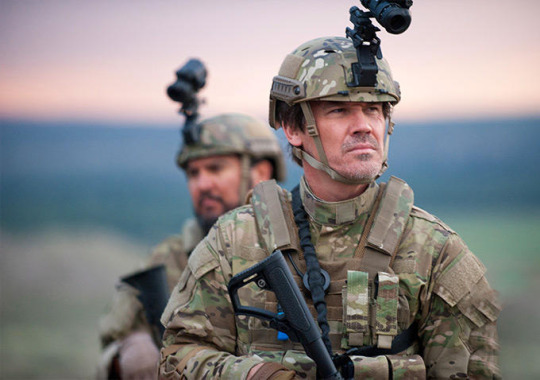
The film opens with a silent, black screen, where the words ‘In Mexico, Sicario means hitman’ are displayed on screen. This works as a simple yet effective way of immediately explaining the meaning of the film’s title. While to some this may seem like a lazy form of exposition, it actually proves to leave a lasting effect on the viewer; knowing that the film’s title essentially translates as ‘hitman’ means that throughout the film, viewers are left guessing which character will prove to be a hitman, and this is something that is left ambiguous until the final act of the film.
The film then cuts to a wide shot of the town of Chandler, Arizona (we are notified of the location via an insert to the bottom left of the screen). The only sound here is diegetic, the sound of the wind and birds in the distance. From the right of the screen, three heavily-armoured SWAT officers enter the frame, and the camera pans to follow them from right to left. The camera eventually stops its pan on one house, where it is shown that a number of SWAT officers are surrounding it. There is then a close-up shot from the interior of the house, showing the shadows of SWAT officers moving past the window.

The next shot is a close-up of the lead character, Kate (Emily Blunt), inside a military vehicle. The camera then cuts to a close-up of Reggie (Daniel Kaluuya), a supporting character, who is shown looking back at Kate, almost suspiciously. The camera then cuts back to Kate, and slowly pans out to show a total of 10 SWAT officers in the back of the vehicle, Kate and Reggie sat opposite each other. The music slowly begins to build in tension, as we hear the vehicle begin to speed up, signified not just by the sound, but by the light pouring through each window, showing that the vehicle is moving at a high speed.
The next shot acts almost as a POV of the vehicle, as if the camera had been mounted on the bonnet, as it rounds a corner at high speed and heads straight for the unguarded wall of a lone house, all the while both the sounds of the engine of the vehicle and the music are building to a climax. The next shot is a fantastic use of match-on-action, as we are shown the interior of the house, in silence, as the vehicle smashes through the wall of the house and into the living room, again the only sound being diegetic, as the wall crumbles and the vehicle enters.
The next shot is from the interior of the vehicle, as SWAT officers run past the camera and into the now adjoining room. The next shot shows someone already inside the room, as they back up from the advancing SWAT officers. As the SWAT officers surround the man, forcing him the floor, Kate advances past them into the rest of the house. Reggie is shown entering another room and apprehending another resident. Note that the time between takes has sped up now, as has the action.
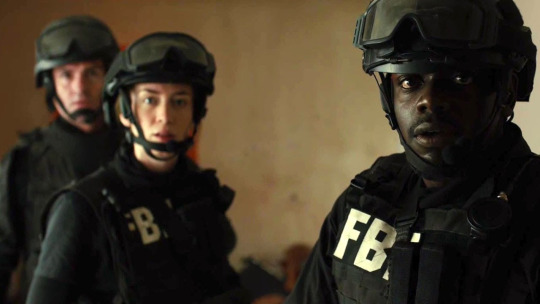
We are then given a long-take of Kate going door-to-door with other SWAT officers, finding that one room is empty and moving on to another one. The SWAT officers stop at one door, and all sound is silent, as they prepare to break into the next room. We are then given an over-the-shoulder shot of Kate, as she quickly enters the room, and someone is shown in the corner holding a shotgun pointed at the door. There is then a very rapidly edited sequence, including over-the-shoulder shots of both Kate and the man with the gun, as Kate dives to avoid being shot, before killing the man with her rifle.
Moments later, after Kate has recovered, Reggie enters the room, and looks at the spot in the wall where the shotgun fired at Kate has created a hole. At this point, we are not shown what Reggie can see on the other side of the wall, just his shocked and confused reaction. Kate joins him at the wall, and from behind we see them both tearing at the hole in the wall, creating an even bigger hole where we can see what is inside. We are then given a close-up of the now larger hole in the wall (which is made of plaster, justifying how Kate and Reggie were able to break it open so easily), where we can see that, within the wall-cavity, there is a corpse, stood upright, wrapped in a see-through material.
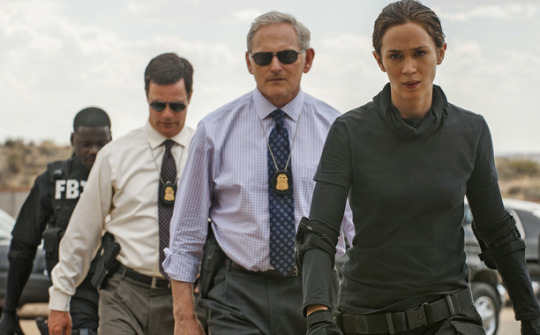
The film then cuts to a scene moments later when Kate, after having gone outside and removed her helmet, returns to the house, where she is told by her boss, Jennings (Victor Garber), that there is a total of 35 bodies in the house. We are then shown a long-shot from the end of the corridor, with Kate, Jennings and Reggie stood at one end, that shows numerous bodies in the walls surrounding them. Reggie is shown leaving the house, and a wide shot of him outside shows him vomiting into the sand, presumably at the sight of numerous, mutilated bodies. Via a two-shot, Jennings tells Kate that the house is owned by Manuel Diaz, who becomes a supporting antagonist later in the film. As Jennings leaves with a hazmat suit-clad forensics officer, we are given a tracking-shot of Kate leaving the house, and entering the garden, and approaching Reggie. As Kate leaves the building, a slow pan reveals a shed at the bottom of the house, which a number of SWAT officers are surrounding.

As Kate turns to look at the shed, it suddenly explodes, sending SWAT officers and debris from the shed flying in all directions, as Kate and Reggie are both blown off their feet. From within the house, we see that Jennings dives to the floor in an attempt to save himself, as the glass in the house’s windows shatters, and dust and sand comes pouring in. With a low angle shot, Kate is shown slowly getting to her feet, and a close-up now reveals that she is sporting a large wound to her forehead, which is causing blood to cover much of her face. As the dust begins to clear, we see Kate’s shocked reaction, and it is shown that she is looking at the severed and bloodied arm of a SWAT officer injured in the explosion, which has landed at her feet.
I believe that one of the reasons this scene is so effective is that Denis Villenueve chose to use almost no non-diegetic sound, something that creates and unnerving and eerie atmosphere. This is also something that Villenueve has done very well in his two of his other notable directorial efforts, Prisoners and Enemy. I think that the fact that almost all of the sound in the scene is ambience makes the scene, and the film as a whole, a very realistic, and at times brutal, depiction of gang and cartel violence around the US-Mexico border.
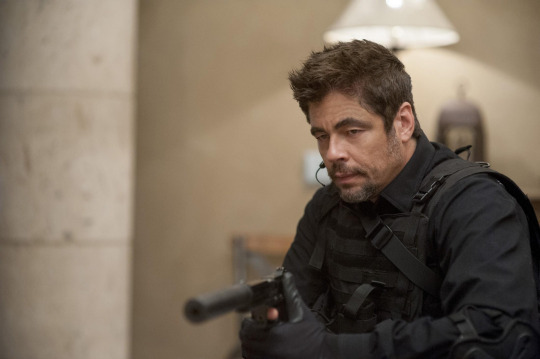
In terms of mise-en-scene throughout this scene (which can be applied to the rest of the film), there are a number of interesting points to note. Firstly, in terms of the actors involved in the project, most are used in ways that are contradictory as to how they have been used in other projects, or atleast their characters and roles are portrayed differently as to how you may expect. In the lead role, Emily Blunt, an English actress, is capable of delivering not just a very believable role, but also of portraying an American without letting her real accent slip. Opposite her is Daniel Kaluuya, another British actor who is capable of acting convincingly both with the dialogue he’s been given, and as an American. The noteworthy detail of these two as leads is that as a mainstream action film, it abandons the traditional principle of having a white, male lead, and instead opts for a white female and African-American male. This is mainly because of director Denis Villenueve’s choice of casting. It is worth noting that, despite not appearing in this scene, Villenueve also cast recognisable actors Benicio del Toro and Josh Brolin in the film, but both against typecasting. Brolin appeared as a laid-back military leader, who offers some comic-relief in an otherwise dark and disturbing film, which means that, despite being a white, male actor, his character acts against what would usually be associated with them. Del Toro, while being Hispanic (del Toro was born in Puerto Rico), and therefore what you might expect in a film about cartel conflict, portrays an intimidating, volatile and unpredictable character, but is also a man of few words, making the dialogue he does have even more unnerving.
In a way to help show how the actors in this scene, specifically Blunt, has been cast against what might have been expected. Blunt is clearly a very attractive actress, but during this scene she solely wears police SWAT uniform, and indeed later throughout the film, she is only really seen wearing military-branded shirts (although there is one shower scene, no nudity is shown, but it’s fairly suggestive).
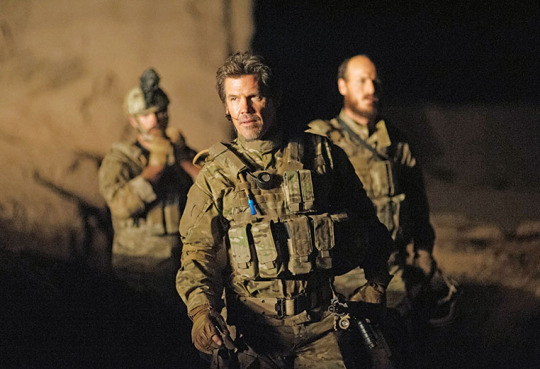
The setting of the scene is particularly noteworthy, as the town (the aforementioned Chandler, Arizona) feels particularly isolated and sparsely populated, emphasised by the lack of background sound in the scene, and the sound of wind being the only real sign of life outside of the central action. The way the scene is lit is also well constructed and designed, but also fairly simple, as all of the shots taking place outside of the house are lit naturally, while all of the scenes from within use natural light effectively too, much of the shots being lit darkly, with daylight entering through the windows. There is no real noteworthy or particularly standout use of blocking in this scene, but the action is choreographed well, all movement looking natural and believable, while the subsequent conversation is well written, believably acted, and the characters of Kate and Jennings stay relatively still while extras move around them.
In conclusion, this scene is beautifully shot, making great use of the landscape, while also showing Denis Villenueve’s unique film-making vision, and is well acted by all involved. It does a great job of going against what the audience may expect from a scene of this genre, but manages to keep the attention of viewers. It’s mise-en-scene is intricately constructed, and well planned, and is a fantastic introduction to the film’s brutally realistic tone.

1 note
·
View note